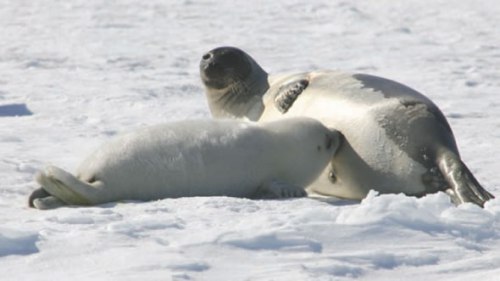Poley Bears is more cuddly than your average polar bears which aren't averse to hunting humans when they feel peckish. A new post at https://wattsupwiththat.com/2017/04/23/sea-ice-off-newfoundland-thickest… … is a guest post by Dr Susan Crockford, a polar bear scientist. It is almost word for word for the same story at https://polarbearscience.com and is written by the same author. She has consistently claimed that polar bears are not under threat and their numbers are in fact increasing. Also, lack of sea ice is not a problem for them as they can swim long distances – and often hunt in the water, surprising seals lying up on fragments of sea ice, very often the situation in summer months. On the other side are the CAGW enthusiasts who claim polar bear numbers are in decline and that sea ice is disappearing at an accelerating pace. So much so that polar bears may become extinct.
In the post at Watts place the two sides are given in interviews done by CBC in Newfoundland. The CBC network is a bit like the BBC, grossly pro CAGW. In this instance the local man is much more pragmatic and it makes interesting reading. Susan Crockford claims the dozen or so sightings of polar bears coming ashore in Newfoundland is connected to the fact that sea ice is the thickest for years in the ocean between Greenland and northern Newfoundland. The poley bears just walked across. This fact is of course one that the CAGW faithful do not wish to hear so the other chap gets to tell us that so much ice has melted in the Arctic that it has pushed remaining sea ice southwards from Baffin Island to block the passage along the western shore of Greenland, and reiterates his belief that polar bears come ashore as a result of melting sea ice. The two views are diametrically opposed to each other. One is telling porkies and the other the facts. See if you can see which.
Seals are an important part of the diet of polar bears – see further at https://polarbearscience.com/2016/02/24/harp-seal-most-abundant-arctic-s… .. which tells us there has been a massive increase in the number of harp seals as a result of the Canadian government putting a stop to the annual cull. It amounts to rich pickings for polar bears – even the poley bear types.
 … Polar bears feed on seals. Each year seals gather in birthing areas in vast herds that are easy to exploit between February and April. Polar bears are often still in hibernation in February and March and this resource is poor as far as calories and gaining weight are concerned. The polar bears arrive in April but their real target are the previous year's seals that have grown plump and must spend time on the ice to moult and gain their adult coats. These seals are nutricious, rich in fat calories, and enable polar bears to gain weight quickly following their hibernation, in order to give birth themselves. Polar bear numbers are rising because seals are so plentiful. Harp seals now number in several millions, quite different from the hey day of clubbing seals during the annual cull. In other words, polar bears are not about to go hungry – CAGW or otherwise. Yet, the opposite is being peddled by the CAGW environmentalists. Why? It will spoil the narrative of the doomsayers. Money and subsidies will dry up. It is a matter of belief -and beliefs always trump reality.
… Polar bears feed on seals. Each year seals gather in birthing areas in vast herds that are easy to exploit between February and April. Polar bears are often still in hibernation in February and March and this resource is poor as far as calories and gaining weight are concerned. The polar bears arrive in April but their real target are the previous year's seals that have grown plump and must spend time on the ice to moult and gain their adult coats. These seals are nutricious, rich in fat calories, and enable polar bears to gain weight quickly following their hibernation, in order to give birth themselves. Polar bear numbers are rising because seals are so plentiful. Harp seals now number in several millions, quite different from the hey day of clubbing seals during the annual cull. In other words, polar bears are not about to go hungry – CAGW or otherwise. Yet, the opposite is being peddled by the CAGW environmentalists. Why? It will spoil the narrative of the doomsayers. Money and subsidies will dry up. It is a matter of belief -and beliefs always trump reality.
